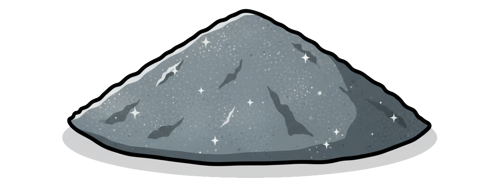Resources
Glossary
Tungsten Carbide (WC)
Tungsten carbide (WC) is a compound of tungsten and carbon that is highly valued for its extreme hardness, wear resistance, and durability. It is one of the most important carbides in industrial use and is commonly found in cutting tools, drilling equipment, and wear-resistant parts. To improve toughness, tungsten carbide is often combined with a binder metal, such as cobalt or nickel, to form cemented carbide, which maintains the hardness of WC while adding greater resistance to fracture.

The material’s properties come from its crystalline structure, where tungsten atoms bond strongly with carbon atoms to create a dense and exceptionally hard substance. Tungsten carbide ranks between 8.5 and 9.0 on the Mohs scale, making it nearly as hard as diamond. It also has a very high melting point of around 2,870 °C (5,200 °F), which ensures excellent stability under extreme heat. Its density is about twice that of steel, giving it a noticeably heavy feel. WC is highly resistant to wear and abrasion, which makes it ideal for demanding applications, although it can also be brittle and prone to fracture under heavy impacts if not alloyed with a binder.
Tungsten carbide is typically produced through powder metallurgy. Tungsten powder is mixed with carbon black and heated at high temperatures in a controlled atmosphere to form WC. To improve its toughness, this WC powder is blended with cobalt, nickel, or iron powders and then sintered into solid components, resulting in cemented carbide products. This process allows manufacturers to shape WC into inserts, tool tips, and other parts that must endure extreme service conditions.
The applications of tungsten carbide are widespread across industries. It is a staple in cutting and machining tools, such as drill bits, milling cutters, lathe inserts, and saw tips. In mining and drilling, WC is used in rock-cutting tools, oil and gas drilling bits, and teeth for tunnel-boring machines. It also serves in wear-resistant components like nozzles, bearings, dies, and valve seats. Outside heavy industry, it is used in jewelry, particularly rings, due to its scratch resistance and durability. In defense and aerospace, tungsten carbide finds use in armor-piercing ammunition and protective armor plating.
The material offers numerous advantages, including exceptional hardness, excellent wear resistance, stability at high temperatures, and long service life compared to steels and many alloys. However, it also has limitations. It is more brittle than steel and may chip or crack under impact or bending stress. It is expensive to produce and machine, and it requires specialized techniques such as precision grinding or electrical discharge machining (EDM). Despite these challenges, tungsten carbide remains one of the most critical materials for industries that demand high performance under extreme conditions.
